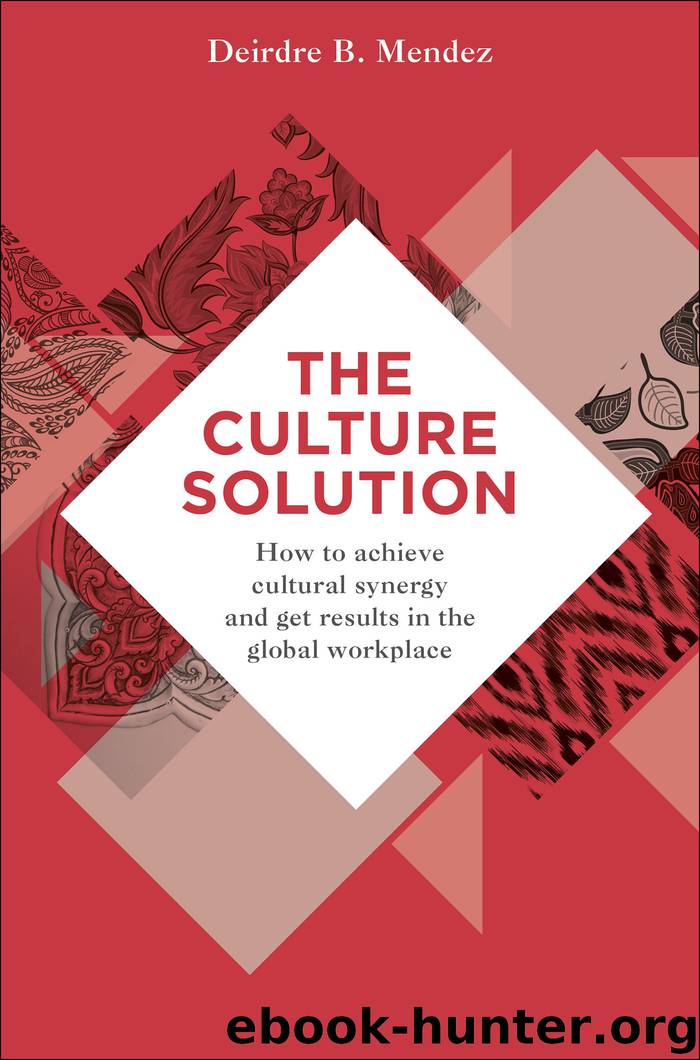The Culture Solution by Deirdre Mendez

Author:Deirdre Mendez
Language: eng
Format: epub
Publisher: Quercus
Published: 2017-02-28T16:00:00+00:00
Analysis
How does hearing Affendi’s side of the story affect your initial interpretation of the situation? You may notice that the cultural tendencies of each participant seem unreasonable when viewed from the other’s perspective, but make more sense when you see the story from their own point of view. That’s because the scenario gives background on the cultural environments of each participant, where their respective behavior is normal and rational. In most intercultural interactions, people don’t have the benefit of this information, and neither side makes any sense to the other.
Below is an analysis of the cultural tendencies that contribute to the conflict in the scenario.
1. Achievement/Endowment (Status dimension)
The mismatch in Nancy and Affendi’s backgrounds and their lack of mutual respect results from different perspectives on Status. Nancy’s Achievement orientation values credentials and performance, while Affendi’s Endowment tendencies cause him to prioritize experience, loyalty, and seniority. Nancy’s strategy for gaining Affendi’s respect—to work hard and demonstrate her competence—is an Achievement-oriented strategy that just seems like showing off to him.
Nancy’s conflict with Affendi over Nazira, a relative of the royal family, also reflects differences on this dimension. Nancy doesn’t accept Nazira’s family connections as a legitimate basis for moving up in the company, thinking she should earn promotions through competence and hard work. Affendi rewards Nazira based on the usefulness of her influence—a different definition of value, but one that she fulfilled.
2. Rule/Situation (Authority dimension)
Differing attitudes toward Authority are responsible for confusion during the companies’ contract negotiations. Autotech’s Rule-oriented contracts surprise Kuching’s Situation-oriented negotiators, who are used to loosely structured contracts that offer mutual flexibility. They are unprepared for Autotech’s rigid enforcement of the contract’s unfavorable terms when conditions change, and Autotech is equally surprised by their request to renegotiate.
The Authority dimension also shows up in the case of Nathan, the Autotech consultant who can’t convince the Kuching engineers to follow his detailed procedures. Nathan, who is Rule-oriented himself, assumes that the Kuching engineers will accept that the rules are valid and recognize his authority as visiting consultant. Kuching’s Situationoriented employees, however, are suspicious of arbitrary rules and need a good reason to follow time-consuming procedures. Nathan fails to explain why each step is important, so they lack the information necessary to make that choice.
3. Network/Process (Involvement dimension)
When Nathan treats the Kuching engineers like “robots,” he violates their expectations regarding Involvement. Creating a personal relationship with the engineers would have helped him gain their compliance, since the Situation orientation values relationships over rules. Nancy’s conflict with Affendi over the adviser’s nephew is also an example of differences for this dimension. Autotech’s Process approach bases hiring decisions on credentials and experience, and Nancy considers it an affront that someone without appropriate skills was assigned to the joint project. Affendi’s Network orientation places high value on Kuching’s relationship with the adviser, and he believes the benefit of the adviser’s goodwill justifies the trouble of managing the nephew. Since this sort of give-and-take is expected in a Network environment, not hiring the nephew could damage their relationship.
Download
This site does not store any files on its server. We only index and link to content provided by other sites. Please contact the content providers to delete copyright contents if any and email us, we'll remove relevant links or contents immediately.
| Ethics | Etiquette |
| Fashion & Image | Health & Stress |
| Motivation & Self-Improvement | Work Life Balance |
| Workplace Culture |
Tools of Titans by Timothy Ferriss(8214)
Change Your Questions, Change Your Life by Marilee Adams(7634)
Deep Work by Cal Newport(6877)
Man-made Catastrophes and Risk Information Concealment by Dmitry Chernov & Didier Sornette(5921)
Playing to Win_ How Strategy Really Works by A.G. Lafley & Roger L. Martin(5913)
Digital Minimalism by Cal Newport;(5661)
Big Magic: Creative Living Beyond Fear by Elizabeth Gilbert(5610)
The Slight Edge by Jeff Olson(5346)
Ego Is the Enemy by Ryan Holiday(5292)
The Motivation Myth by Jeff Haden(5155)
Stone's Rules by Roger Stone(5026)
The Laws of Human Nature by Robert Greene(4996)
Tuesdays with Morrie by Mitch Albom(4685)
Eat That Frog! by Brian Tracy(4431)
Rising Strong by Brene Brown(4377)
Skin in the Game by Nassim Nicholas Taleb(4161)
Bullshit Jobs by David Graeber(4094)
The Money Culture by Michael Lewis(4074)
Skin in the Game: Hidden Asymmetries in Daily Life by Nassim Nicholas Taleb(3929)
